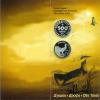Bustard
Bustard (Otis Tarda). issued in 28 July, 2003. The Great Bustard, Otis tarda, is in the bustard family, the only member of the genus Otis. It breeds in southern and central Europe, where it is the largest species of bird, and across temperate Asia. European populations are mainly resident, but Asian birds move further south in winter. Sizeable populations exist in Hungary, Portugal, Slovakia, Russia and Spain, but the species is declining due to habitat loss throughout its range. The male of this huge bird is possibly the heaviest extant bird capable of flight, alongside the similarly sized Kori Bustard. An adult male typically is 90-110 cm (3-3.7 ft) long with a 2.1-2.5 m (6.9-8.2 ft) wingspan and usually weighs from 10 to 16 kg (22-35 lb).[1] The heaviest known bird was about 21 kg (46 lb), although larger specimens have been reported but not verified. An adult male is brown above and white below, with a long grey neck and head. The breast and lower neck sides are chestnut. In the breeding season, the male has long white neck bristles. In flight, the long wings show large areas of white. The female is 30% smaller (typically 80 cm in length and 1.8 m across the wings) and one-third the weight of the male, averaging 3.5-5 kg (6-11 lb). Perhaps because of this, there is a slewed sex ratio of about 1.5:1 female to male. The breast and neck of the female are buff. Both sexes are usually silent. Immature birds resemble the female.
Obverse:
On the face side of the coin in the center the legend "500 ТЕҢГЕ" is located in two rows indicating the face value of the coin. Under it the figure "2003" indicates the year of coinage. Above figures it is a heraldic representation of a spiral. Along the circumference the legend "КАЗАКСТАН YЛТТЫК БАНКІ" in Kazakh language. On the upper left part of the coin, in two lines of circumference there are elements of traditional ornament, on the right side - a circle inscription "Ag 925. 24gr.", indicating the production metal, its standard and weight, and the trade mark of Kazakhstan Mint.
Reverse:
On the back side of the coin there is a representation of the bustard against steppe background. At the upper and right side of the coin, along the circumference there is an inscription "ДУАДАҚ" in Kazakh language and "OTIS TARDA" in Latin language - zoological name of the specie.
Package (box, booklet, roll, etc.):
Country:
Kazakhstan
Catalog ID:
KZ60CM1
Krause ID:
KM# 53
Value:
€85
Mintage:
3000
Quality:
Proof
Face value:
500 tenge
Purity:
0.925
Weight:
24g
Diameter:
37mm
Year:
2003
Type:
Commemorative coin
Shape and style:
Round
Edge:
Plain
Local program:
Red book of Kazakhstan
Animals:
Bustard
Source of information:
The National bank of Kazakhstan www.nationalbank.kz
Source of information:
Wikipedia www.wikipedia.org This coin is available in our shop. Click add to cart button or product name link for details.
Product name: Kazakhstan 2003 Bustard
Price: EUR85.00





